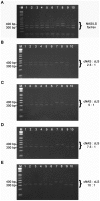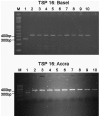Development of a temperature-switch PCR-based SNP typing method for Mycobacterium ulcerans
- PMID: 23166851
- PMCID: PMC3499370
- DOI: 10.1371/journal.pntd.0001904
Development of a temperature-switch PCR-based SNP typing method for Mycobacterium ulcerans
Abstract
Mycobacterium ulcerans (M. ulcerans), the causative agent of the devastating skin disease Buruli ulcer (BU), is characterized by an extremely low level of genetic diversity. Recently, we have reported the first discrimination of closely related M. ulcerans variants in the BU endemic Densu River Valley of Ghana. In the study real-time PCR-based single nucleotide polymorphism (SNP) typing at 89 predefined loci revealed the presence of ten M. ulcerans haplotypes circulating in the BU endemic region. Here we describe the development of temperature-switch PCR (TSP) assays that allow distinguishing these haplotypes by conventional agarose gel-based analysis of the PCR products. After validation of the accuracy of typing results, the TSP assays were successfully established in a reference laboratory in Ghana. Development of the cost-effective and rapid TSP-based genetic fingerprinting method will thus allow investigating the spread of M. ulcerans clones by regular genetic monitoring in BU endemic countries.
Conflict of interest statement
The authors have declared that no competing interests exist.
Figures




Similar articles
-
Single nucleotide polymorphism typing of Mycobacterium ulcerans reveals focal transmission of buruli ulcer in a highly endemic region of Ghana.PLoS Negl Trop Dis. 2010 Jul 20;4(7):e751. doi: 10.1371/journal.pntd.0000751. PLoS Negl Trop Dis. 2010. PMID: 20652033 Free PMC article.
-
Application of real-time PCR in Ghana, a Buruli ulcer-endemic country, confirms the presence of Mycobacterium ulcerans in the environment.FEMS Microbiol Lett. 2010 Mar;304(2):191-4. doi: 10.1111/j.1574-6968.2010.01902.x. Epub 2010 Jan 18. FEMS Microbiol Lett. 2010. PMID: 20146745
-
Spatiotemporal Co-existence of Two Mycobacterium ulcerans Clonal Complexes in the Offin River Valley of Ghana.PLoS Negl Trop Dis. 2016 Jul 19;10(7):e0004856. doi: 10.1371/journal.pntd.0004856. eCollection 2016 Jul. PLoS Negl Trop Dis. 2016. PMID: 27434064 Free PMC article.
-
The genome, evolution and diversity of Mycobacterium ulcerans.Infect Genet Evol. 2012 Apr;12(3):522-9. doi: 10.1016/j.meegid.2012.01.018. Epub 2012 Jan 28. Infect Genet Evol. 2012. PMID: 22306192 Review.
-
Buruli ulcer (Mycobacterium ulcerans infection).Trans R Soc Trop Med Hyg. 2008 Oct;102(10):969-78. doi: 10.1016/j.trstmh.2008.06.006. Epub 2008 Jul 26. Trans R Soc Trop Med Hyg. 2008. PMID: 18657836 Review.
Cited by
-
DNA microarray chip assay in new use: early diagnostic value in cutaneous mycobacterial infection.Front Cell Infect Microbiol. 2023 Jul 1;13:1183078. doi: 10.3389/fcimb.2023.1183078. eCollection 2023. Front Cell Infect Microbiol. 2023. PMID: 37457951 Free PMC article.
-
Methodological and Clinical Aspects of the Molecular Epidemiology of Mycobacterium tuberculosis and Other Mycobacteria.Clin Microbiol Rev. 2016 Apr;29(2):239-90. doi: 10.1128/CMR.00055-15. Clin Microbiol Rev. 2016. PMID: 26912567 Free PMC article. Review.
-
Genetic diversity of PCR-positive, culture-negative and culture-positive Mycobacterium ulcerans isolated from Buruli ulcer patients in Ghana.PLoS One. 2014 Feb 10;9(2):e88007. doi: 10.1371/journal.pone.0088007. eCollection 2014. PLoS One. 2014. PMID: 24520343 Free PMC article.
-
Late onset of the serological response against the 18 kDa small heat shock protein of Mycobacterium ulcerans in children.PLoS Negl Trop Dis. 2014 May 22;8(5):e2904. doi: 10.1371/journal.pntd.0002904. eCollection 2014 May. PLoS Negl Trop Dis. 2014. PMID: 24853088 Free PMC article.
-
Whole genome comparisons suggest random distribution of Mycobacterium ulcerans genotypes in a Buruli ulcer endemic region of Ghana.PLoS Negl Trop Dis. 2015 Mar 31;9(3):e0003681. doi: 10.1371/journal.pntd.0003681. eCollection 2015 Mar. PLoS Negl Trop Dis. 2015. PMID: 25826332 Free PMC article.
References
-
- Johnson PDR, Stinear T, Small PLC, Pluschke G, Merritt RW, et al. (2005) Buruli Ulcer (M. ulcerans Infection): New Insights, New Hope for Disease Control. PLoS Med 2: e108 doi:10.1371/journal.pmed.0020108 - DOI - PMC - PubMed
-
- Stinear TP, Hong H, Frigui W, Pryor MJ, Brosch R, et al. (2005) Common evolutionary origin for the unstable virulence plasmid pMUM found in geographically diverse strains of Mycobacterium ulcerans. J Bacteriol 187: 1668–1676 doi:10.1128/JB.187.5.1668-1676.2005 - DOI - PMC - PubMed
-
- Yip MJ, Porter JL, Fyfe JAM, Lavender CJ, Portaels F, et al. (2007) Evolution of Mycobacterium ulcerans and other mycolactone-producing mycobacteria from a common Mycobacterium marinum progenitor. J Bacteriol 189: 2021–2029 doi:10.1128/JB.01442-06 - DOI - PMC - PubMed
-
- Qi W, Käser M, Röltgen K, Yeboah-Manu D, Pluschke G (2009) Genomic Diversity and Evolution of Mycobacterium ulcerans Revealed by Next-Generation Sequencing. PLoS Pathog 5 doi:10.1371/journal.ppat.1000580 - DOI - PMC - PubMed
-
- Hong H, Coutanceau E, Leclerc M, Caleechurn L, Leadlay PF, et al. (2008) Mycolactone Diffuses from Mycobacterium ulcerans–Infected Tissues and Targets Mononuclear Cells in Peripheral Blood and Lymphoid Organs. PLoS Negl Trop Dis 2 doi:10.1371/journal.pntd.0000325 - DOI - PMC - PubMed
Publication types
MeSH terms
LinkOut - more resources
Full Text Sources
Miscellaneous

